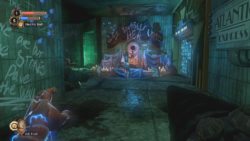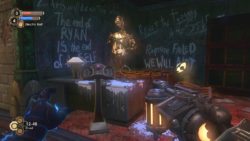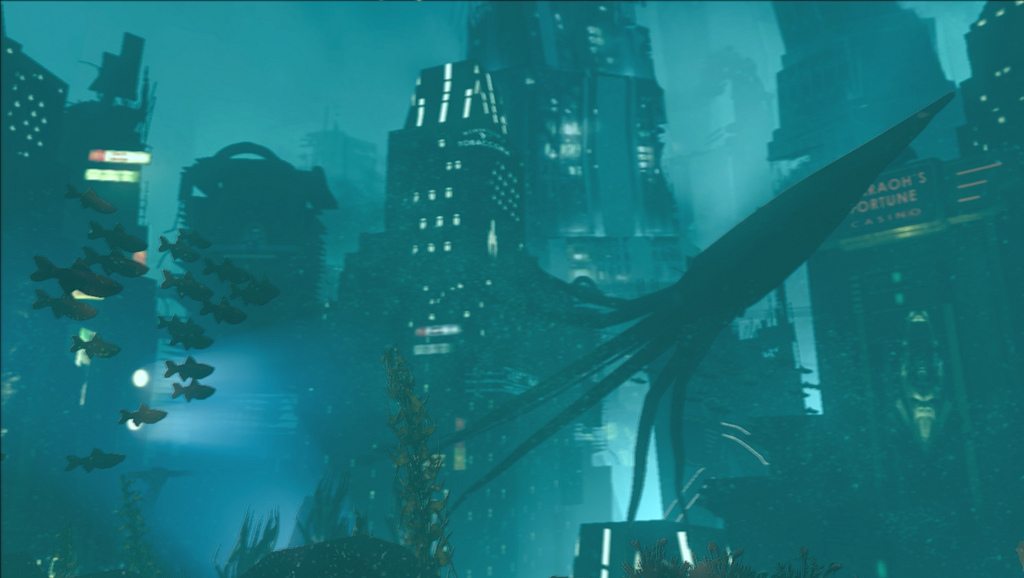Bioshock 2 Link to the Past Retrospective

Very little has been discussed of Bioshock 2. Dismissed only as the disappointing middle child in the Bioshock trilogy, struggling to compete intellectually and narratively with its bold and intriguing siblings. Upon acquiring the Bioshock Collection I saw the game as a mere extension to its predecessor, something that I would try to find as much enjoyment from as I could. However, as I began to play I discovered that I was enjoying myself immensely, without any conscious effort on my own part. The game replicated Bioshock and Bioshock Infinite’s ability to ooze suspense, drama and anticipation. The flaws of the game are clear, however I believe that the strengths have been much overlooked, and the weaknesses of the other games in the series understated.
Gameplay
The gameplay itself seems a good place to start. There are very few changes between Bioshock 2 and 1. The first person perspective, the ammo-deprived weaponry and the maniacal splicers all reprise their roles for this sequel. One major change made to the game is perhaps the most infuriating aspect of it. In the first game you, the player, were expected to destroy the iconic ‘Big Daddies’, to get to the equally iconic ‘Little Sisters’. Though these were optional fights, they were very beneficial as they allowed for you to gain access to the perk supplying ‘Adam’ that the Little Sisters collected.
The sequel includes these big daddy brawls but also throws in two (thankfully optional) ‘hold your position’ sections, in which your rescued Little Sister would spend a lifetime draining the Adam from a corpse, while all the Splicers of Rapture attacked you. However, upon rescuing or harvesting all the Little Sisters of a level you are also forced into a much harder fight with the new ‘Big Sisters’ in the game. This fight was particularly a partially difficult and enduring fight, as you had just recently drained all of your resources fighting the Big Daddies and the many Splicers. I came to despise these battles, and I think most of the gaming community shared my frustration.

Flickr, Tom Francis
Besides from this admittedly infuriating game mechanic, the second game makes a number of tweaks and changes that actually improve on the formula set up by the first game. You are given multiple melee options which allow for you do dash at and attack your enemies more easily. Though I think it near impossible to primarily use melee attacks instead of ranged, this does provide more variation to the gameplay. I also found that the sequel is a little more forgiving in terms of ammunition. At no point in the second game did I find myself scrambling through a level with nothing to fight back with but a pathetic melee weapon, like I had done multiple times in the first game. This is not something that I found myself missing.
The hybridization of her scientism, religious worship and voluntary syndicalism creates a fascinating ideology and an intriguing villain
Level Design
Many criticised the game for its lack of creativity in terms of level design compared to the first. Unfortunately, there is nothing in the second game that rivals the fantastic ‘Fort Frolic’, with an insane Sander Cohen rambling down the radio at you and weeping angel-esque Splicers sneaking up behind you. However, for every ‘Fort Frolic’ in the first game, there was also a ‘Proving Grounds’ level. This level consisted of a number of escort quests where you were forced to follow the Little Sisters around, moving at the speed of molasses, and protect them from waves of splicers. (Sound familiar?). A number of levels and set-pieces however, were rather beautiful in Bioshock 2. The merry-go-round in Dionysus Park, the wax-work figures in Ryan Amusements and the drowned streets of Siren Alley stand-up against many of the creations in Bioshock.

Flickr, Tom Francis
Ideology and Story
Perhaps, the greatest criticism however, was that supposedly dubbed down ideological and philosophical messages of the first game. Bioshock is a fantastic analysis of Ayn Rand’s concept of ‘objectivism’, a philosophy that bolsters the selfish acts of the individual as the great drivers of progress. The second game however is an examination of objectivism’s rival; collectivism. The propaganda and speeches that the main protagonist, Sofia Lamb, spouts were fascinating. The hybridization of her scientism, religious worship and voluntary syndicalism creates a fascinating ideology and an intriguing villain. She is ruthless and uncompromising, but also impassioned and incorruptible. This, I found, to be a far more interesting story than the fight against two selfish and greedy men, interested only in their own ambitions, that the first game put me up against.
There is no killer ‘would you kindly’ twist at the end, which is perhaps why many were disappointed. However, the second game needed to demonstrate that it was capable of devising a story and a message independent of the first game, and it did.
Conclusion
Is Bioshock 2 a perfect game? No. Does it fall short in a couple of places that the other two games in the series didn’t? Yes. However, this is still a Bioshock game, created by Irrational games under the leadership of Ken Levine. The atmosphere of the game is beautifully morbid, the characters complex and original and the dilemmas and messages of the game as, if not more, interesting than Bioshock and Bioshock Infinite. With the Bioshock Collection available, and at a very attractive price, I therefore encourage anyone with some spare time on their hands to seek this game out and prepare for a great time enjoying this much overlooked sequel.

Comments (1)
A great article, but I’m afraid you’re wrong about who made it. Irrational played no part in it and Ken Levine wasn’t involved beyond some initial guidance whilst handing over the franchise to 2K Marin. After the success of Bioshock 1, 2K wanted a sequel fast. They asked Irrational for one but Irrational wanted to do something different (they were already planning Infinite at this point.) So they gave 2K permission to hand off Bioshock 2 to another studio so they could churn it out quickly whilst Irrational worked on Infinite.